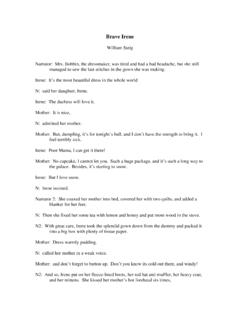Transcription of Oxidation & Fermentation in Tea Manufacture - …
1 Oxidation & Fermentation in Tea Manufacture By Robert J. Heiss The Manufacture of tea is a series of integrated steps that starts with freshly-plucked leaf and ends with what we in the trade refer to as finished', or made' tea. The six classes of tea (green, yellow, white, oolong, black, and Puerh) have several steps in common (such as plucking, primary sorting, finishing, etc.) as well as other aspects that are unique to only one or several par- ticular finished tea(s). Oxidation is one of the latter, a chemical process that must occur in the Manufacture of Golden Monkey Feng Huang several of the classes of tea, and prevented in others. In fact, the world of tea has historically been divided into two broad categories based on whether or not a finished tea has been oxidized. Oxidation in Tea First, let's define Oxidation : Oxidation is a biochemical, enzymatic activity during which oxygen is absorbed by and subsequently causes changes to the White Pekoe Bai Mudan host physical matter.
2 In the case of freshly plucked leaf for tea, this is plant matter. Oxidation can be spontane- Manufacture of white, oolong, and black teas. An exact- ous or controlled and cause positive or negative change. ing phase of controlled Oxidation is one of the most im- A familiar example of spontaneous negative Oxidation portant components of the Manufacture of both oolong is what happens when one cuts an apple or banana and and black teas. Green and yellow teas are prevented leaves the cut side open to the air. The exposed cells from oxidizing by meticulous steaming, drying and/or absorb oxygen, soften and turn brown. This is a very frying techniques often called de-enzyming'. simple form of Oxidation that most people have wit- Oxidation is a chemical process that requires nessed. Left undisturbed, the fruit may simply air-dry an abundance of moist, oxygen-rich air.
3 For black tea or it may rot, depending on the atmospheric conditions production, Oxidation rooms (or chambers) must pro- present in the room. Similarly cutting an apple into vide fifteen to twenty exchanges of humidified air per slices and drying these in a dehydrator is an example of hour to guarantee complete Oxidation . The polyphenols controlled negative Oxidation , occurring within the pro- in the leaf (tea catechins) absorb a significant quantity cess of drying. The browning of the cut surfaces is not of oxygen, particularly during the early stages of oxida- considered aesthetically pleasing in the marketplace, so tion. Oxidation in tea Manufacture officially begins sulfur compounds or citric acid are sometimes used to during the withering stage as spontaneous Oxidation , mitigate the color change, but Oxidation occurs in this and then accelerates gradually during the subsequent situation even without a visible change in color.
4 Steps necessary to transform fresh leaf into finished During the Manufacture of tea, both sponta- black tea. After several preliminary steps, prepped leaf is neous and controlled Oxidation occurs. Spontaneous ready for the controlled Oxidation process that is often Oxidation occurs during the withering phase of the incorrectly referred to as Fermentation '. Several chemi- In general, theaflavins contribute to the brisk and bright taste of black tea, while the thearubigins are what provide strength (depth or body) and color. Carbon dioxide is also being driven out of the leaf, and heat is exchanged. If the temperature of the leaf is allowed to rise too high, the controlled Oxidation will rage out of control; and if it falls too low, Oxidation will cease. At this point the oxidizing leaf takes on a new moniker in Indian/Western tea classification: dhool.
5 Oxidation requires two to four hours and is controlled by experience, not by science. Although there may be technical markers for determining a prospective end to the process, so many variables come into play that Taiping Hou Kui the best method for concluding that the proper oxida- tion level of the leaf has been reached is to rely on the experienced nose and eye of the expert monitoring the process. cal reactions that together comprise Oxidation take The tea master must control the thickness and center stage now under the controlled environment raking of the leaf, which determines the exposure of the of the official' Oxidation phase in the Manufacture surface area of the dhool to the air; the ideal ambient of black tea. In traditional Oxidation the sieved leaf is temperature (85 F, or 29 C) and relative humidity (98.)
6 Spread out in a thin layer (maximum 2 to 3 inches, or 5. percent); and the ventilation (fifteen to twenty com- to 8 centimeters) on the floor of the factory, on tables, plete changes of air per hour). Also, the environment or perforated trays that are similar to the withering must be completely hygienic; bacteria must be prevent- troughs used during the (earlier) withering stage. The ed from ruining the dhool. oxygenation of the polyphenols stimulates them to start During Oxidation the dhool goes through a the series of chemical reactions that ultimately yield the predictable series of flavor profiles: brisk, high color, flavor components and cup characteristics that we ex- and overall strength. The tea master can direct the dhool pect in black tea. During the first and most important into a particular style by adjusting the length of time al- period of the enzymic oxidations, the enzymes polyphe- lowed in Oxidation in combination with regulating the nol oxidase and peroxidase act on other polyphenols to temperature/humidity of the Oxidation chamber.
7 Most produce theaflavins. These red-orange compounds then tea is manufactured to yield a balanced cup showing react with more polyphenols to produce thearubigins, bright liquor, good intensity in the aroma, and a solid the chemicals responsible for changing the leaf 's color full body. When the tea master has determined that the from green to golden, coppery, or chocolate brown. The dhool is oxidized to the desired level ( fully oxidized' is a thearubigins, meanwhile, are also busy reacting with degree, not an absolute) the critical phase of controlled some of the amino acids and sugars in the leaf, creating Oxidation is halted by the final process of black tea the highly polymerized substances that develop into Manufacture : drying. the various and distinctive flavor components that we expect in black tea Fermentation in Tea into Puerh must be exposed to bacteria (or have bac- Fermentation is an important component in the teria present inherently) in order for Fermentation to fabrication of Puerh and other aged teas like Liu An, occur.
8 Liu Pao, some oolongs, etc. Therefore, any discussion of As is the case with the fabrication of traditional Fermentation in tea Manufacture ideally focuses on hard' cider or Roquefort cheese, the bacteria necessary and is well illustrated by the Manufacture of Puerh. for microbial activity to commence is present naturally, So let's examine what Fermentation is and why careful, in the atmosphere and/or on the interior surface(s) of expert Fermentation is so integral to the Manufacture of the chamber in which the Fermentation occurs (the traditional, high-quality Puerh. While it is one of the cider-house or cheese-curing cave). In the case of Puerh, oldest and simplest forms of tea production, the world the bacteria required to both initiate and maintain fer- of Puerh is complex and exacting, to the extent that mentation are potentially present during several aspects volumes have been written on the subject by Asian tea of its production: experts.
9 However, we will not examine the specific com- plexities of the different types of Puerh Manufacture 1. On the surfaces of the leaf of the old-growth plants here, as this article seeks only to offer a more general themselves in the primordial forest where the large-leaf description of Fermentation and Oxidation . tea trees grow most famously in the mountains of the Fermentation is microbial activity involving one Xishuangbanna district of southwestern Yunnan Prov- or more types of bacteria. By definition, Fermentation ince, China. occurs most readily in the absence of oxygen, though exposure to some is ideal for aging Raw (Sheng) Puerh. 2. In the controlled environment of the tea-production While an abundance of oxygen is required for most rooms in which the Raw' (Sheng) mao cha' is tem- aspects of tea Manufacture , exposure to oxygen during porarily stored as it awaits compression; in the piles Puerh Manufacture is often reduced or eliminated after of mao cha during the artificial Fermentation of Ripe the withering stage.
10 The leaf that is being transformed (Shou) Puerh; and finally in the humid steam-enriched environment in which the cakes are compressed. 3. To a lesser degree, in the monitored curing rooms where Sheng Puerh cakes are stored during post-fermen- tation and aging. After several preliminary steps, prepped leaf is ready for the con- trolled Oxidation process that is often incorrectly referred to as Fermentation '. During the Fermentation phase of Puerh manu- Fermentation of Shou Puerh are stacked thickly, densely, facture, several important factors must coalesce. Fol- and with minimal surface area exposed. The critical lowing the harvest of the appropriate leaf, there should bacterial activity being encouraged at this point requires be wild' bacteria available on the leaf itself; this will some oxygen replenishment, but, as with a mulch pile range from very little' to an abundance' (#1 above).







